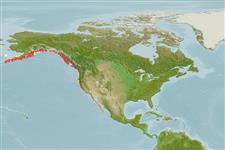Common names from other countries
Classification / Names / Names
ชื่อสามัญ | ชื่อพ้อง | Catalog of Fishes (gen., sp.) | ITIS | CoL | WoRMS
Environment: milieu / climate zone / depth range / distribution range
นิเวศวิทยา
; ระดับความลึก 0 - 55 m (Ref. 95344). Temperate, preferred 5°C (Ref. 107945); 61°N - 35°N, 169°W - 120°W
Eastern Pacific: Alaska, Canada and USA. From Aleutian Islands to Pismo Beach, California.
Length at first maturity / ขนาด / น้ำหนัก / Age
Maturity: Lm ?, range 9 - 11.75 cm Max length : 18.0 cm SHL เพศผู้/กระเทย; (Ref. 95344); อายุสูงสุดที่ได้รายงาน: 19 ปี (Ref. 126990)
Typically found along the intertidal zone on surf-exposed beaches with siphon shows exposed on the substrate (Ref. 95344).
Life cycle and mating behavior
วัยเจริญพันธุ์ | การสืบพันธุ์ | การวางไข่ | เซลสืบพันธ์ของเพศเมีย(ไข่) | ความดกของไข่ | ตัวอ่อน
Members of the class Bivalvia are mostly gonochoric, some are protandric hermaphrodites. Life cycle: Embryos develop into free-swimming trocophore larvae, succeeded by the bivalve veliger, resembling a miniature clam.
Lassuy, D.R. 1989. (Ref. 78181)
IUCN Red List Status (Ref. 130435)
CITES status (Ref. 108899)
Not Evaluated
Not Evaluated
Human uses
การประมง: การค้า
FAO - การประมง: landings | FishSource | ทะเลรอบๆเรา
เครื่องมือ
แหล่งที่มาจากอินเตอร์เน็ต
Estimates based on models
Preferred temperature
(Ref.
115969): 5.6 - 12.6, mean 8.9 (based on 118 cells).
ความสามารถในการกลับคืนสู่ปกติ
ความสูง, เวลาต่ำสุดที่จะทำให้ประชากรเพิ่มขึ้นเป็น 2 เท่าใช้เวลาน้อยกว่า 15 เดือน (K=0.59; tm=2; tmax=19).
